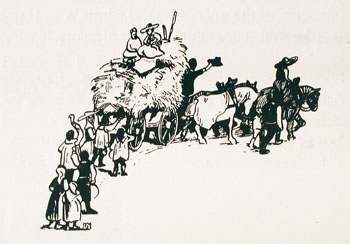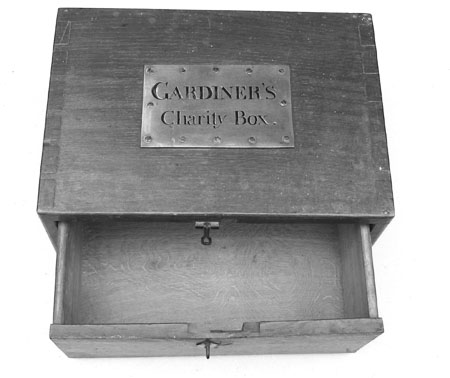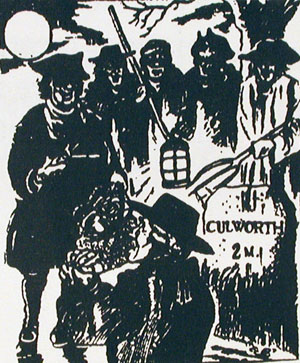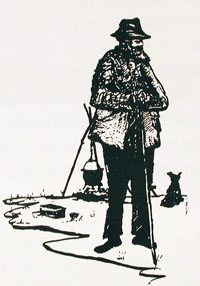
SULGRAVE CHARITIES
(Back to Chapter 3 Index)
On 29th March 1700, John Timcocks willed £10 for the benefit of the poor of Sulgrave, the gift to be administered by the minister, church wardens, and the overseers of the poor. The capital was to be invested and the interest distributed at the direction of the Trustees.
John Walker added £20 on the 5th April 1715 under the same conditions. A gift of £2 by the "parishioners of Sulgrave" on 4th November 1717 brought the total to £32 which was used to purchase land in Helmdon Parish. A rent charge of £3.4s (£3.20p) was levied on the land to give the first regular income of the trust which was subsequently entitiled "Timcock's and Walker's Gifts" (recorded by the Charity Commissioners on 27th March 1759).
Thomas Ash bequeathed £5 for the benefit of the poor on 11th January 1742 and a further "person unknown" gave £3. The will of John Haycock on 21st August 1749 specified rent charges on various pieces of land to produce £2 per annum for distribution to the poor on St Thomas' Day.
As with all other bequests to the charities, the income remains the same to this day, since all the owners or occupiers of land subject to charitable charges have long since redeemed the annual liabilities by paying to the Charity Commissioners lump sums which will provide interest sufficient to discharge those liabilities.
All of the above charities eventually became known as "Haycock and Walker's Charities" and are to this day paid out by the Trustees on St. Thomas' Day, 21st December.
The will of John Hodges dated 18th June 1722 (a copy of which is held by Sulgrave Charity Trustees) provided for two rent charges of £4 each on the field known as Peasfurlong in the Parish of Culworth. The first of these charges was to provide 3d (1.5p) worth of bread for each of six poor people on every Lord's Day, provided that they attended divine service. The second charge provided the salary for a school teacher to instruct ten poor children who were to learn to read, write and cast accounts. John Hodges required not only the minister, church wardens and overseers of the poor to administer his charity but added the constable and the surveyors of highways to the list of trustees.
See here for John Hodges' Breadbook 1783 -1919.
The will refers to a schoolhouse recently built by John Hodges in the corner of Pargiters Close adjoining Stockwell Lane where the children were to be taught. He provided for the upkeep of the building by requiring that the owners or occupiers of Peasfurlong accept the liability for repairs and maintenance.
A recent ruling by the Charity Commissioners is that this liability is not now enforceable in law and the present occupier has refused to accept the liability. Fortunately, other sources of finance are available when repairs to the listed building become necessary.
Robert Gardiner was the greatest benfactor of the parish, his deed of 2nd February 1763 covering education being followed by his will of 7th December 1776. The will provided a range of help for the poor as well as recognition for the trustees, which took the form of an annual dinner.

Charges on the land and income from Gardiner's £500 bequest were stipulated to provide:
| Bread for 12 poor people on every Lord’s Day | £7 16s 0d |
| Education for my six charity boys | £5 0s 0d |
| Entertainment for the trustees on Valentine’s Day | £1 1s 0d |
| An apprenticeship for one of my charity boys each year | £10 0s 0d |
| A coat and cap for each of my six charity boys | £3 0s 0d |
| A fee for a sermon to be preached by the Vicar on Valentine's Day | £1 1s 0d |
| A donation to the county hospital, Northampton | £1 1s 0d |
| Beef to be distributed to the poor on Valentine’s Day | £9 3s 6d |
| Augmentation of the trustees entertainment | £0 15s 0d |
There was a further stipulation that if the interest on the £500 was insufficient for all commitments to be met in full the poor should have less beef. At this time the cost of beef was about 3.5d (1.5p) per lb, so the full £9 3s 6d (£9 18p) would buy almost 630lbs. As the number of recipients was around 70 and they received some 3 - 6 lbs according to the size of their families, it is assumed that the revenue sometimes fell short of expectations. At the 1793 distribution Mr. Malsbury (trustee) contributed 1.5d to the fund as it appears the quantity of beef exceeded the budget by that amount.

The Gardiner's Charity Box in which the relevant
documents were kept for over 200 years.
Of course Robert Gardiner's charity boys were taught in John Hodges' school and it was on 5th May 1755 that:
"John Chester of Westhorpe in the parish of Marston-St-Lawrence in the County of Northampton did by the desire of Rt. Gardiner come to Sulgrave to teach the charity boys and others committed to his care in the charity school appointed for that purpose. He continued so doing till Valentine 1793, being 37 years 9 calendar months and 9 days. Quite worn out with illness did then yield it up to the Rev. Richard Wykham Clark, Edward Haycock and Walgrave Moore, the only surviving trustees of the late Rt. Gardiner, Wm. Malsbury and Robert Wyatt, church wardens, John Whitton and Thomas Stuchfield, overseers of the poor, who did admit Wm. Hawkes schoolmaster to be teacher in the said school during their pleasure."
Written records of the period bear testimony to John Chester's effectiveness as a teacher and his astuteness is born out by a report to the trustees on 25th February 1786 as follows:
"As there is yearly allow'd 15 yards of blew cloth to make the six charity boys' coats which hath ever since the beginning of this said charity been very sufficient to make good full coats for 6 large boys, and enough for each boy to mend same during that said year.
But the last three years being very little boys and their coats being made very scanty in every part, so scanty indeed that it was beneath the Dignity of the Trustees to put up with such usage -
Therefore, I, John Chester, then schoolmaster took upon me to make it appear Manifest before the Revd. Mr. Wykham, Mr. John Whitton, Mr. Joseph Pecover, Thos. Hawkes, Mr. Moore and Daughter that there was a Defraud by Wm. Coleman the Tailor who made the said 6 coats, And in their presence did prove it in the following manner by buying 2½ yards of the same cloth which weighed 2lbs 5oz and for 6 boys 13lbs 14oz.
When the incidental items of shag collars (6oz), 3 dozen metal buttons (3oz), 2 yards of fustian for the pockets (8oz), Thread, Twist and Canvas Staytape (4oz), there was a total weight of 15lbs 3oz.
However the coats when made and bits to mend them weighed only 10lbs 10oz and even if amounts for Whipping for clipping and nipping were added there was a total of only 12lbs leaving a weight of cloth of 3lbs 3oz or about 3½ yards unaccounted for.
Is this not a Plain Proof of Defraud.
25th Day of February 1786"
There appears to have been further wrong-doing by William Abbott who had been Parish Clerk for some years and had recorded the distribution of the charity bread. In 1787 as a member of the notorious Culworth Gang he was sentenced to death at Northampton Assizes for Highway robbery although the sentence was later commuted to transportation for life to Botany Bay.

A conveyance was signed between Walter Harding and James William Harding (Vicar of Sulgrave) on 11th May, 1887 in the presence of William Whitton, solicitor of Towcester, and witnessed by John Henry Cave and Richard Wilson.
"And in consideration of £225 the freehold estate comprising what is now known as the School house together with land on which the school was subsequently built together with the garden and play ground passed into the keeping of the Vicar and the witnesses. All the building thereon, or to be erected to be used as and for a school for the education of children and adults or children only of labouring and manufacturing and other poorer classes in the Parish of Sulgrave aforesaid and for no other purpose."
Robert Gardiner's bequest of £1 1s 0d (£1.5p) annually to Northampton Hospital was put to good use as the following records show:
The name of those as have been sent to the Northampton Hospital for relief since March the first, 1780.
1. Thomas Whitmill 1780 returned cured
2. Mary Giles 1781 'do' not cured
3. Elizabeth Mills 1782 'do' not cured
4. Wm. Harpur 1783 'do' cured
5. Thos. Lambdon son of Richard Lambdon 1787 This poor lad's leg was taken off and he returned cured.
6. Daniel Humphrey 1789 Aged 60 was sent to the hospital to see if he could be cured of  a cancerous face and chin. On Friday the 20th day of November 1789 with 15s to be deposited to the governors of the hospital in case of death, likewise 2s more was given him by Mr. Brockley the overseer, and other sums as 3 or 4 shillings as to bear his charges in going and lying out on the Friday night. This poor unthinking creature goes to Foster's Booth on Friday night and there stays till Sunday morn and then sets off for Northampton, arriv'd there on Sunday stays there till the Monday week following which was the 30th day of November, then returned home peniless. This poor creature never went to the hospital tho' he stay'd there so long. This bad face soon killed him after his return.
a cancerous face and chin. On Friday the 20th day of November 1789 with 15s to be deposited to the governors of the hospital in case of death, likewise 2s more was given him by Mr. Brockley the overseer, and other sums as 3 or 4 shillings as to bear his charges in going and lying out on the Friday night. This poor unthinking creature goes to Foster's Booth on Friday night and there stays till Sunday morn and then sets off for Northampton, arriv'd there on Sunday stays there till the Monday week following which was the 30th day of November, then returned home peniless. This poor creature never went to the hospital tho' he stay'd there so long. This bad face soon killed him after his return.
December 18th 1790. Joseph Wiseman the Younger to the Hospital to be cured of the rheumatism; stay'd three weeks returned cured.
October 28th 1793. Benjn. Pervo to the Hospital to be cured of a bad face. Returned cured at one month's end.
May 23rd 1801. Martin Humphrey staid 3 weeks, had his leg taken off.
January 9th 1802. William Satchwell staid 3 weeks, returned cured.
September 29th 1808. Susanna Wiseman staid 9 weeks, returned incurable.
September 28th 1809. Wm. Treadwell staid 6 weeks, returned cured.
1843 January. George Potter returned cured."
The extremes of detail between the entries for Daniel Humphrey and George Potter make one wonder about the characters of the people recording the events.
The earliest indenture in the possession of the Trustees records that Thomas Pargiter was apprenticed to George Hinson of Slapton to learn the trade of Butcher. Many similar indentures follow, the premium paid by the Trustees being £10 per annum, usually over a three year period.
In modern times, as indenture premiums are no longer payable, the "apprenticehips money" is used for the purchase of tools approved by the Master. A single gift of approximately £30 represents the three annual premiums formerly paid.
The gifts of bread and beef have long been discontinued. Government legislation made the bread charity impossible when the only loaves allowed to be produced were the standard "large" and "small" loaves which we know today. Previously the charity loaves were each worth 3d and varied in size according to ingredient costs. Bread was still distributed until 1933 but thereafter cash was given in lieu.
The cost of beef is recorded in 1897 as 6¼d per pound but as costs rose in the 20th century it became necessary to resort to the distribution of money, the available funds from both bread and beef charities being given out on St. Thomas' day.
Coats and caps continued to be made until the 10 shillings available for each became insufficient for the purpose and a small cash gift to the local school children was substituted. By this time, around 1900, the charity school of John Hodges had been absorbed into the Church of England school as part of the state education system.
In 1977 a radical overhaul of the charities was instituted by the Charity Commissioners and this resulted in the various bequests being grouped under one of two headings:
1. Gardiner's Education Charity. This covers all the requirements of John Hodges and Robert Gardiner's educational trusts so far as these can be met in the twentieth century by providing tools for apprentices and specific gifts to the school for purposes benefitting all pupils. The latest use of educational funds went some way towards purchasing a computer for the school. At first sight this is a long way from the use of funds envisaged by the benefactors, but the principle of providing education for children of the parish is closely adhered to. Since the closure of Sulgrave school the educational funds benefit Culworth school to which Sulgrave children have been transferred.
2. A Relief in Need Scheme. This scheme is designed to cover all the wishes of the other charities in helping those in need in the parish. It is still the practice for cash gifts to be made to some elderly and infirm parishioners on St. Thomas' Day to afford them some small comfort at Christmas.
The recent history of the Sulgrave Charities may be seen as mundane in comparison with the eighteenth and nineteenth centuries. Through decreasing money values, reducing needs resulting from the Welfare State and various legislation governing some charitable acts, current practice is far less colourful, but today's trustees administer the funds very much in the spirit of the bequests, if not precisely to the letter. The 1939-45 war effectively made the customary Trustee's dinner impossible and it is now the custom for the Trustees to gift their allowance into the general exchequer of the Relief in Need scheme.
Following the account of the way in which the charities are administered near the end of the 20th century it seems appropriate to record the names of the trustees and it is interesting to note the continuing commitment of some families in trustee service.
Kenneth Tattersall, chairman of the trustees is a descendant by marriage of Mr. Malsbury who figured largely in the very early days of Sulgrave charities.
Donald Taylor, treasurer, followed his father who was chairman for many years and his mother served as secretary during the same period from the 1920s to the middle 1950s.
Rodney Henn also followed his father who served from 1934 to 1991 being Chairman for some 30 of those years, a tremendous record of community service.
Sidney Wootton is a long serving member; again following a long tradition of community service by his family.
Donald Barrett is, dare one say, a comparative newcomer, having lived in Sulgrave for over 40 years, his family being Greatworth residents. He not only serves as a trustee, but, as a member of the Billiard Club, also takes a keen personal interest in the maintenance of the charity school, nowadays known variously as the reading room or the billiard room.
Last, but not least, the vicar of Sulgrave is an automatic appointee to the board of trustees. Over many years various incumbents have made superb contributions to the work, notably Rev. William Harding, who was largely responsible for the founding of the Church of England School, and Rev. Pakenham-Walsh, who documented much of the information now revealed. The present trustee on behalf of the Church is Rev. Simon Crawley.
See here for an Example of the Register of The Sulgrave Charities.